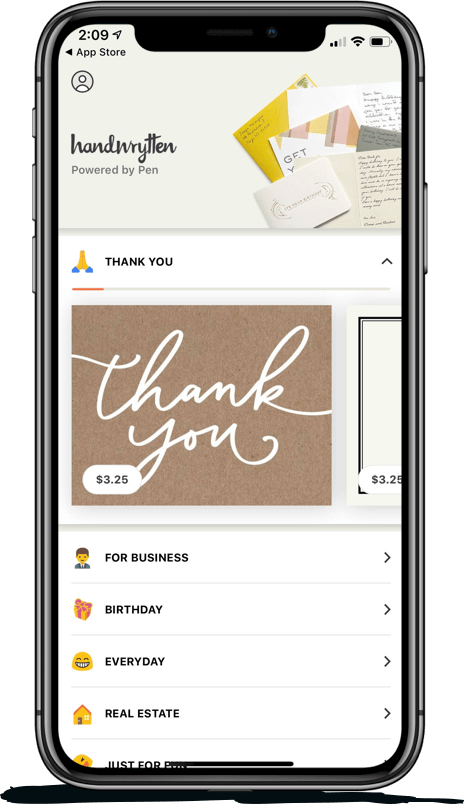
9280 S. Kyrene Rd.
Suite 134
Tempe, AZ 85284
Phone: +1 (888) 284-5197
Email: contact@handwrytten.com



You have been subscribed. Thank you!
Originally posted October 31, 2022
Automotive marketing has existed for a very long time, with the very first car advert appearing in 1898. The headline? “Dispense with a horse”.
Nowadays, telling prospective car buyers not to buy a horse is not necessarily the most effective automotive marketing strategy. Automotive marketing, according to Amazon, simply helps dealerships connect with prospective car shoppers. This includes those who are actively looking to purchase a car and those who are still in the process of researching.
In the modern day, however, there are only a few automotive marketing strategies that rely primarily on non-digital pathways.
Referrals are an invaluable part of car dealership marketing strategies. This strategy refers to using connections with recent clients to help you expand your customer base.
For example, say you sell an SUV to John. Throughout the entire process, he consistently mentions how easy you are making the car buying process for him, and how other dealers clearly care more about the money than about making the experience friction-free for him.
After he purchases the SUV, you reach out to John with a car sales thank you note asking him to refer you to anyone he knows is also in the market for a vehicle. This message can be as simple as:
Hey John,
I’m glad we were able to get you an SUV that makes you happy! I noticed that throughout the car buying process, you mentioned a few times how easy I made it for you.
I’m ecstatic that I was able to provide a quality customer journey for you- if you know anyone who would also appreciate the same level of service, I would love the opportunity to work with them, and there’s an extra incentive for you in the form of a $100 gift card for any referrals you send my way.
Regardless, thank you for your time, John! Talk soon,
[name]
Outreach, in general, is also an invaluable automotive marketing strategy to keep in mind when discussing classic strategies.
This is an extremely effective marketing strategy for automotive marketers. Reaching out to your existing and past clients is an integral part of customer engagement. But so many marketers in the auto industry completely miss out on this easy way to improve their holistic strategy.
Customer outreach just means emailing or texting past and current customers to offer, well, anything.
If it has been multiple years since they last bought their car from you, offer to help them set up a service appointment.
If there is a dealership event occurring soon, reach out to a lot of your customers to see if there are any prospects interested in attending; this will boost long-term customer retention and will also serve to fuel the aforementioned referrals.
You can even keep track of how long it has been since customers have bought a new car- then send them automated updates about newer car models, upgrades, and even deals that have begun recently.
When it comes to customer outreach, all you need to do is think about your target audience: trust your intuition. What demographic have you sold a new car to in the past? What kind of communication do they prefer? Use your intuition to think about how to most effectively reach customers. This may include a combination of social media platforms and mobile ads to boost the scope of consumers you can reach.
Using social media to get in contact with previous and potential customers leans a bit more into the modern day of automotive marketing: automotive digital marketing.
Automotive marketing is the forefather of digital automotive marketing. But while automotive marketing relies mostly on earlier forms of communication like thank-you notes, billboards, and handwritten notes, digital marketing relies on what the name implies: digital avenues.
Think of any way that a company has offered some sort of information to you in the past through the web: email, content copy, advertisements, or a manipulable website to allow for quick product comparisons. The most effective marketing campaigns will include all of these in some form, but in the automotive industry, there are some key marketing strategies to target potential buyers.
These strategies are not necessarily set in stone, directly applicable to every dealership, or even easily replicable. This is because the vast majority of these strategies are mindset adjustments that will allow you to think like a customer. Prioritizing your target customers and their customer journey will ensure that what they want is what they get; and when the customer is happy, customer retention is ensured.
Make the car buying process extremely easy for the customer, and avoid frequent mistakes made by car dealerships. According to information from Google, 95% of vehicle buyers use the web as one of their sources of information, with 60% of those searches coming from mobile devices. This means that having a simple website design and ample information available online can only help you further into the future.
You should also keep in mind what the customer may want to do when looking at a new car. They are probably interested in comparing vehicles from the top down, including key features like price, mileage, and size. This is why providing an excellent user experience is crucial; take Hyundai’s website for example.
On their vehicles page, it is easy to see where they have taken the time to adjust and optimize their customer journey. You can click to compare vehicles, see the aforementioned features side by side, and can even compare Hyundai vehicles to non-Hyundai vehicles, all on one website. This allows customers who are interested in making a fast decision to have a huge amount of information at their fingertips.
In the end, this can only benefit your target audience; a customer who has a fluid experience researching a car will likely find it much easier to purchase that car in a dealership.
Another way that Hyundai has adjusted their marketing strategy is by establishing key performance indicators that align with their business goals. For example, using things like Google Store Visits and Sales for tracking search engine marketing changes. If a digital campaign is put in place, and Google Store sales are up, that KPI has made it clear that the campaign was successful.
In doing a similar strategy to Hyundai, you can learn how to not only get more sales but also learn what the customer needs to drive better long-term growth. Think about the opposite of the above example – the digital campaign has led to an increase in-store visits, but there is not a proportional increase in conversions. In this situation, this points to a potential gap in customer service, allowing you to adjust how you think about your customer experience accordingly.
In Google’s Dealer Guidebook, they detail the average prospect’s mindset when it comes to purchasing a new car.
To begin, a person looking for a new vehicle will likely search for the most suitable version of what they need. In the case of a mother with three children, she may search for “best minivan for 5 person family”. Ranking well for organic keywords like this, as well as implementing keywords like this into your Google Ad spend would allow you as an automotive marketer to get one foot in the door where many do not.
This prospect will then research different features they may need in a car – perhaps our example prospect needs one TV in the car, as well as a sliding middle row. Providing easily accessible informational content on your website, similar to what Hyundai includes on their, allows you to influence the buyer’s decision.
Shoppers want to know immediately if they can afford a vehicle they’ve determined fits their needs best, looking up keywords like “Ford F150 quote” to determine if it is in their price range. Ranking for these keywords would also allow you to provide information in a place where few dealers currently do.
Searches like “car dealerships near me” or “F150 test drive near me” are keywords that your ads should almost certainly appear for. This is the second to last step of Google’s five-step Consumer Moment, and is arguably one of the most significant. If a customer researches the kind of car they want to buy, determines the price and why it is the right vehicle to get, but cannot actually find a dealership near them due to poor Google Ads management, that is a massive issue.
Even after shoppers have made their decision, they will still want to confirm that they are getting the cheapest deal. At the end of the ‘Consumer Moment’, it is extremely helpful to make sure that you highlight deals or promotions in your ads. This will ensure that you do not lose customers at this key part of the customer journey.
As aforementioned, throughout many stages in the car buying process, buyers will do research on specific models of cars that they are interested in. In the beginning, they may simply look up “best minivan” or “best long bed truck”; towards the end of the process, their searches may be centered around finding a deal, looking up “Toyota Camry deals”.
Bidding for relevant keywords through Google Ads is extremely important here; considering 95% of new vehicle buyers use online sources at some point during the purchase process, appearing for searches that your dealership should appear for is obvious, but tends to be overlooked.
Included in Google’s Dealer Guidebook are multiple case studies that show the benefits of Google Ads in automotive marketing. For TurnKey Marketing and City KIA, an adjustment of their bidding strategy to focus on effective cost per click (eCPC) was intended to optimize for consumer intent, rather than relying on minute adjustments in keywords.
The result was significant in three ways: a 122% increase in ad traffic to the website, a whopping 35% increase in search conversions, and a 900% increase in display conversions. These numbers alone suggest that this enhanced targeting strategy led to new customers that were more interested in the cars they were advertising for.
Keep in mind, however, that each business owner will have a different optimal smart bidding strategy. Determining which one makes the most sense depends on key information like your target market, locality, size, and priority metrics.
Developing a comprehensive list of keywords to bid on is the first of a two-step process; the second is arguably more important.
Say you are bidding on the keyword “compact sedan” and have assigned it to be broad match. Without getting too into the nitty gritty of Google Ads, broad match simply means that searches your keyword will appear for include wide combinations of variations of your keyword that are still relevant. In this instance, “compact car” or “small sedan” could appear.
Without a negative keyword list, searches for “compact toy sedan” or “small toy sedan” could make your ad appear, leading to wasted ad spend.
Implementing a negative keyword list will take time, but is extremely helpful to ensure that you are not spending money where it does not need to be spent. A few strategies to do so, in short, are to look at what search terms are appearing for your keywords (adding irrelevant terms to your negative keywords) and to add negative keywords that may be a no-no in your industry (think: no toy cars involved in automotive marketing!)
Many smaller automotive dealerships fall into the fallacy that their Google My Business reviews are not that relevant. However, responding to online reviews, positive and negative, is extremely critical.
Nearly 90% of consumers say they read online reviews when researching a product; combined with the fact that you can potentially increase customer churn by 15% if you don’t respond to reviews, paying attention to your Google My Business profile is extremely helpful.
Think about it this way: if the only online reviews that are responded to are good reviews, it will appear like you are avoiding dealing with any issues your business may have. Even worse, if you don’t actively manage any reviews, it just looks like you don’t actually care about customer feedback. With the number of reviews written for every dealership out there (look at the above image), this is crucial to long-term success.
More than 40% of shoppers who watched a video about trucks or cars visited a dealership as a result; this is an impressive number. If you can get four out of every ten people to visit your dealership simply by creating a compelling, well-produced video, that is an easy win.
Investing time and money into your video marketing is not the most obvious of things. However, from the consumers’ perspective, it only gives them more reassurance that shopping with you is the right choice. If members of your team appear to be friendly, helpful and have the customers’ interest at heart, it is just logical to assume that people would then want to visit your dealership.
According to the co-owner of Turbo Marketing Solutions, an agency that specializes in automotive marketing strategy, all auto industry competitors, including manufacturers, marketing companies, and dealers, are competing for the attention of the same seven to nine percent of the population. This small percentage only represents those in the market for a vehicle; the other 91%, those who do not currently consider themselves ‘in the market’, are not targeted.
Sean Cassy, the co-owner, argues that a few key friction points are the difference between having a person keen on changing their vehicle and one who believes it is simply unnecessary.
By frequently updating consumers with price updates, including a litany of different payment plans, prospective car buyers can feel more comfortable knowing exactly how much they would be paying for a specific vehicle. When it is unclear or difficult to see the actual cost of a potential car, customers are dissuaded from continuing in the purchasing process.
Remove this barrier to entry by having clear pricing; optimally, including a list of actively updated vehicles with their respective prices would make customers feel more confident in choosing to shop with you.
The trade-in value of a vehicle has long been a subject of discussion, primarily because there is always a certain amount of haggling that comes about when it comes down to it. Providing a trade-in value calculator on your website can eliminate any uncertainty that could creep into play at this stage.
As we’ve already mentioned, in the automotive industry, the shift from a traditional marketing strategy to a digital one has largely already occurred. But, based on information gathered by Treasure Data, Winterberry Group, and Ansira, there are two general automotive marketing trends to expect in the near future.
With the COVID-19 pandemic came lockdowns, fear, and a large increase in consumption of digital media. More and more buyers transitioned from visiting in-person showrooms to digital ones; from viewing a car in person to panning around a 3D rendering online. This is further observed in data from a Cox Automotive report, where two in three people are more likely to complete their purchases online.
As the online era continues to come to fruition, this number will likely only grow; consumers’ desire for easily accessible and easily manipulable information will only continue to increase. Focusing on providing an incredible user experience will help you to stay ahead of the curve. This also means that shifting away from TV ads and leaning into paid search and content creation is the next logical step. This is because it is simply easier to track the impact of digital marketing campaigns than TV campaigns or car sales thank you cards.
Tangentially related, but as we shift further into this digital era, the overall sales model for the automotive industry is quickly changing from a traditional sales model where the dealer’s first interactions with the customer are crucial, to the European dealer agency model where the manufacturer is now doing much more of the marketing and optimization. We’ve written an in-depth piece that discusses what this means for dealers, which should hopefully give more context as to how to proceed in 2023.
Before the advent of the Internet, car manufacturers did not really have to invest that much in advertising. They could theorize, design, and create the vehicles they wanted to, shipping them out to car dealerships across the nation, leaving the sales and marketing strategy to local teams. But now that the entire nation is connected… things have changed.
Looking from the top down is extremely critical here: if the auto manufacturer does not have a say in what all of their dealerships are doing, or have key metrics picked out to be tracked across the board, there will be no consistency between dealerships. It will be impossible to say if Dealership A is more successful than Dealership B because it is in a larger, more wealthy area. This is because they simply provide a better customer experience and have a fantastic website, bringing them more overall customers.
Even further down the pipeline, ensuring that the entire sales team in a dealership operates with the goal of providing a fantastic customer experience is key. If all parts of an organization are not unified with the same end goal in mind, it will not be easy to consistently scale and improve processes, as sticking points in social media will be unclear.
Unifying the types of tracking tools being used should be the first step; in an automotive business, it makes quite a bit of sense to use the Google Suite. Google Ads and Google Analytics provide solid analytical data on what kind of car buyers are researching your platform, and which are not. Google Analytics, specifically, will also provide key metrics on your website’s performance to determine at which point in the sales funnel customers are being lost.
In general, though, keeping a close eye on your social media channels to see what customers are asking for, how they react to specific pieces of content that you post, and how they interact with your brand in general are crucial to understanding your audience. We’ve recently written a guide to automotive social media marketing – check it out to stay on top of every channel.
There are a wide variety of digital platforms you can use to enhance your automotive marketing strategy. The core thing to focus on is how the customer may react to something.
If you can place yourself into the customer’s shoes and understand what they want and when they want it, you fundamentally will get why the platforms and methodologies mentioned above will benefit you.
One non-digital marketing strategy we did not mention throughout this article is using handwritten notes. Interestingly enough, handwritten notes are highly appreciated by customers and are also forms of outreach that are low risk and high reward according to our research.
While we did note above that print marketing is largely dead, there is a significant difference in how a person psychologically receives a handwritten versus a printed note. When a note is handwritten, it feels more personal. It conveys the message that you, the automotive dealer, care about your customer. Not only will this help you to retain more customers, but it will also spike the amount of people who refer you to their friends.
Check out our handwritten notes for automotive dealers if you are interested in automatically sending handwritten cards to your customers.
According to Autojobs.com, an automotive marketing manager plans and oversees an individual dealership’s marketing and promotional activities. In addition, he or she develops budgets and acts as a liaison with the media and other companies. An automotive marketer, in general, can expect to do something similar, but perhaps at a smaller scale: focusing on specific car dealerships, and developing better search engine optimization and outreach strategies.
Customer experience in the automotive industry is no different from customer experience in general: it is every aspect of the customer journey, from outreach to the first point of contact to purchase.
Optimizing the customer experience will help to boost long-term customer retention. Other things like consistent customer outreach, asking for referrals, as well as offering customers rewards will incentivize them to become repeat customers. This will enable them to reach out to potential customers on your behalf.


Scale your handwritten outreach, creating positive impressions and long lasting bond.
Sign Up Today!


Over 100 designs to choose from or design your own. Our online card customizer makes it simple.
Check Out Our Cards!





